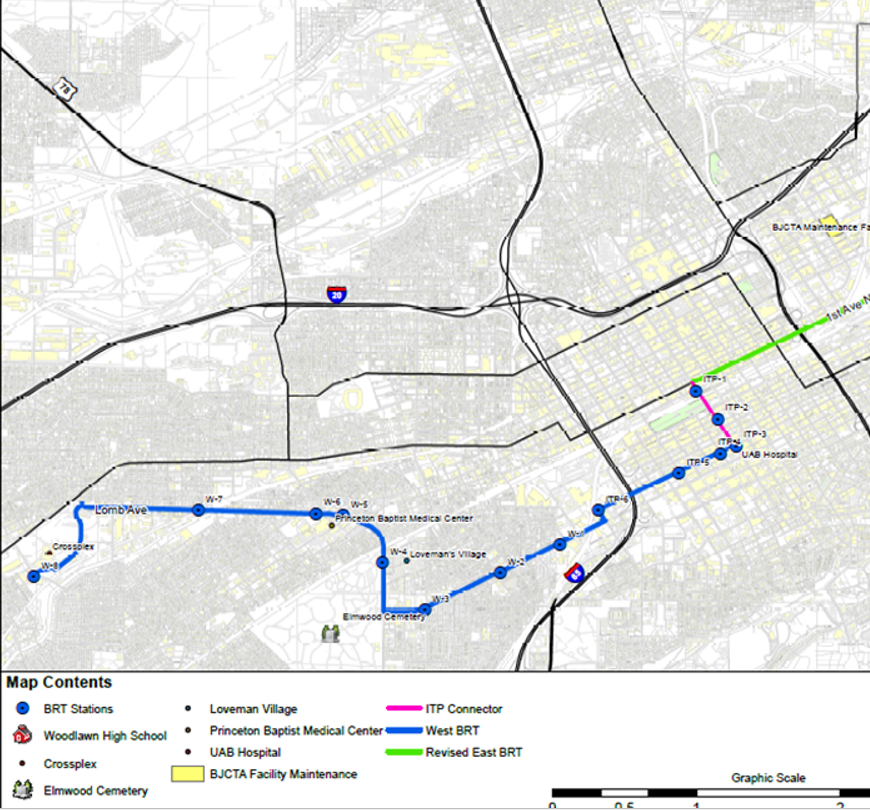By Ariel Worthy
The Birmingham Times

Over the next decade, Birmingham city officials plan to create a high-capacity “world-class” transport system that will provide neighborhoods with access to educational and employment opportunities, and vital services, they say.
On Monday, August 22, transit officials offered details on a Birmingham Bus Rapid Transit Project (BRT Project) during a meeting held at the Five Points West Public Library.
Darrell Howard, project manager for STRADA Professional Services, an engineering and consulting firm, said the Birmingham Rapid Transit will be a “train on rubber tires.”
“The buses would ride in exclusive lanes,” Howard said. “It would stop at locations in certain neighborhoods, or where there are jobs, entertainment or both.”
The new system will feature 15 new low-sitting buses, with 18 stops on each side, totaling in 36 stops, and the entire trip will take an estimated 50 minutes. Another new feature will be an easy pay system.
“We are looking at ticketing machines and smart cards, as well as phone apps like Apple Pay,” Howard said. “It will speed up the process and make the trip quicker, without having to slow down the trip and pay on the bus.”
Because of Birmingham’s growth, it’s important the city has a transit system like other major metropolitan areas, Howard said.
The BRT will be a modern, enhanced transit line through Birmingham’s Jones Valley along the U.S. 11 corridor and will connect the Woodlawn Community through downtown Birmingham with the West End Community. Along the way, it will serve major employers such as Integrated Medical Systems, the University of Alabama at Birmingham, and Brookwood Princeton Medical Center. It will connect 25 neighborhoods to services, and provide residents with greater access to opportunities, according to the city.
In July surveyors interviewed riders on 11 routes throughout the current transit system.
“One of the biggest complaints we’ve had from people is that they don’t know if they have missed the bus or not,” Howard said.
According to the survey about 19 out of 80 riders were unsatisfied with the availability of a bus schedule. With the new system, Howard said they would be able to access the location and schedule of buses at a station or on their phone via an app.
“[The buses] will run frequently enough to where if they miss a bus they’ll say, ‘That’s fine the next bus will be here soon,’” he said.
The new transit line will replace the Birmingham Jefferson County Transit Authority’s (BJCTA) MAX bus services that currently operate in these corridors, greatly improving reliability, mobility, capacity and operations on BJCTA’s highest ridership corridors.
The new system will also help with timeliness for riders. In the survey over 70 of the riders said they were dissatisfied with the on time performance of the buses.
Of the people surveyed, 91 percent of the riders were black, and 41 percent of the riders made under $10,000 annually. More riders were also satisfied in the value for the fare they paid.
With the BRT, they are also looking at how to improve the new bus system.
“If we don’t fix the local buses, the new system won’t work well,” Howard said. “Max is working to get a transit development plan; they want the existing bus routes to work better. We’re going to recreate the local bus system around the BRT.”
The goal is to have the BRT in place in time for 2021 World Games.



